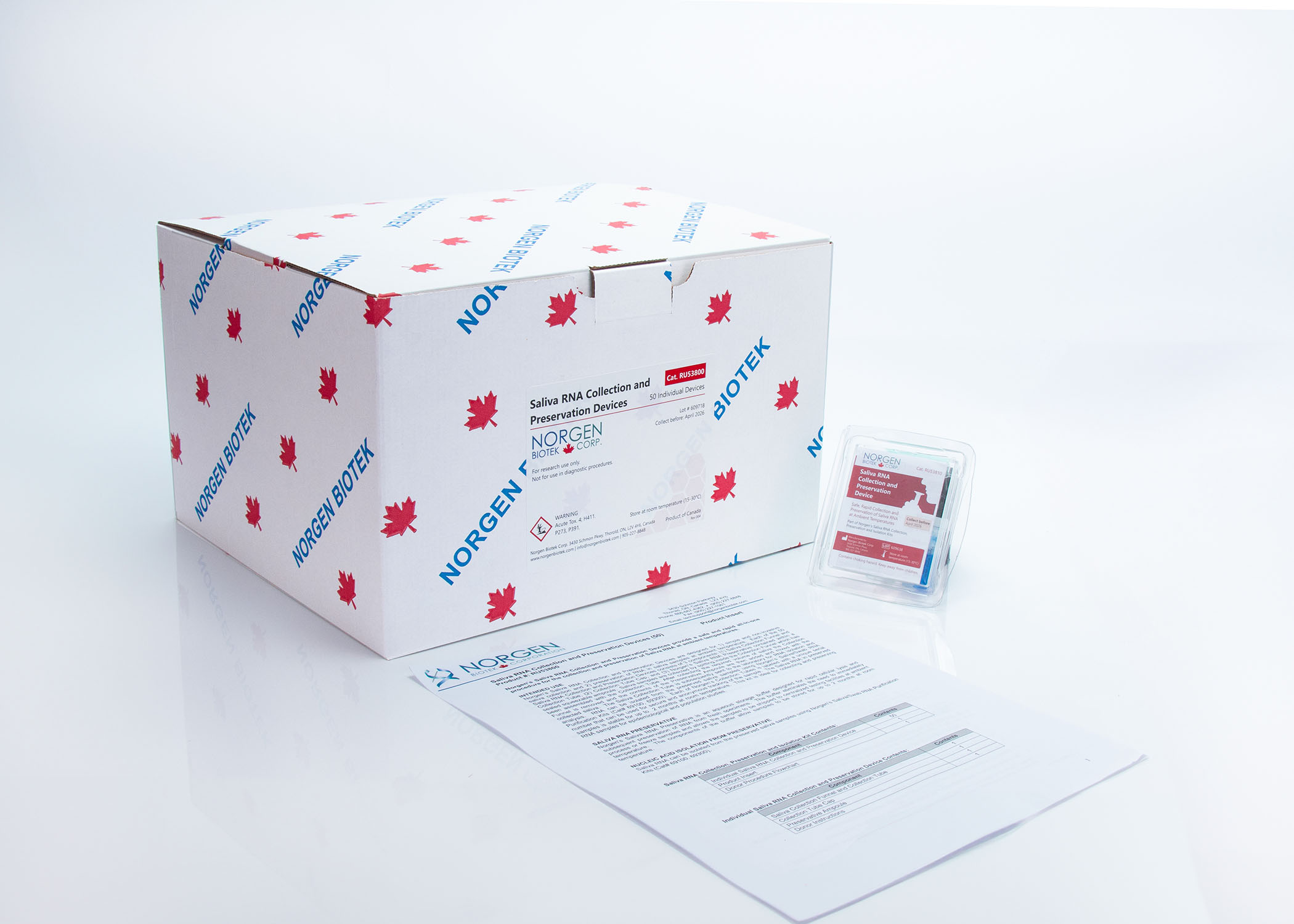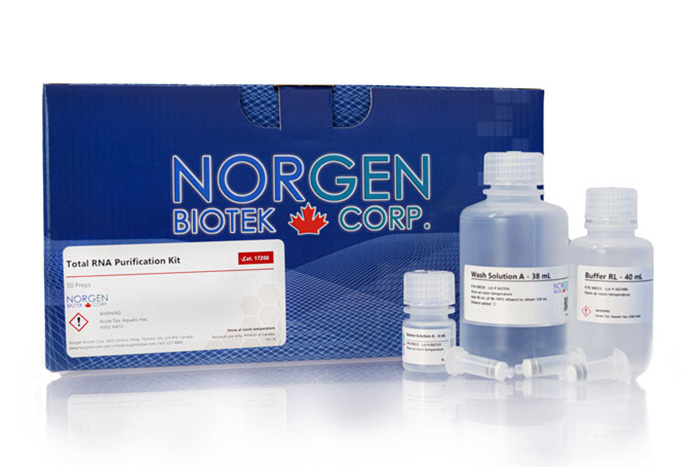Saliva/Swab RNA Purification Kits
For the purification of total RNA from non-preserved saliva and nasal/throat swabs, and from preserved saliva
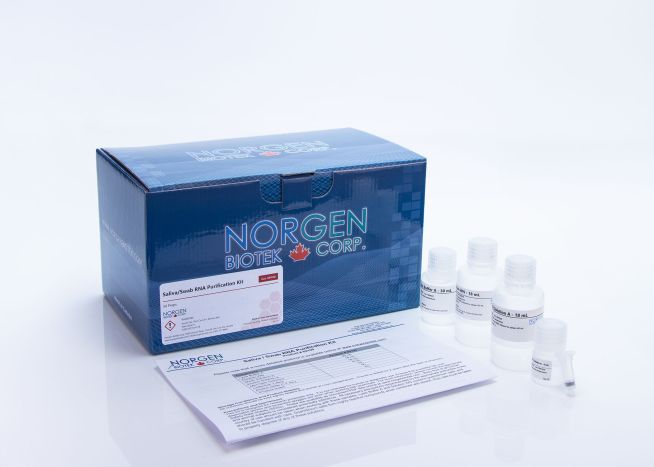
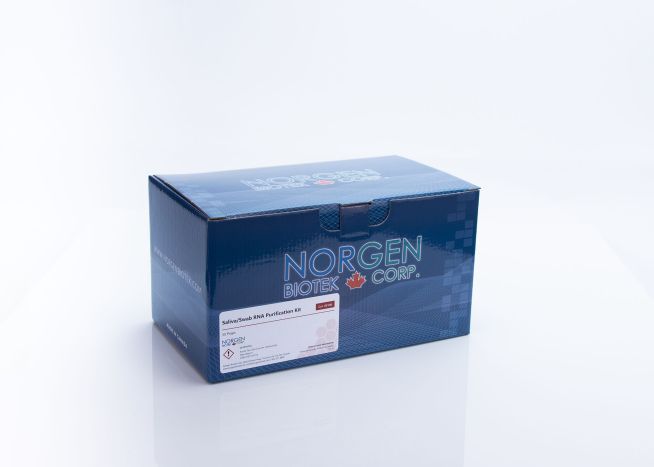
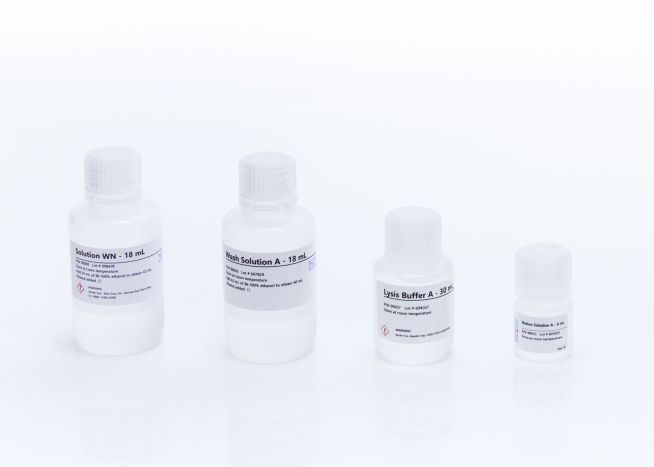
For research use only and NOT intended for in vitro diagnostics.
Saliva/Swab RNA Purification Kits
For the purification of total RNA from non-preserved saliva and nasal/throat swabs, and from preserved saliva
Register today to receive an exclusive 15% off* on your first order.
Features and Benefits
- Fast and easy processing using either a rapid spin column or automation friendly high-throughput 96-well plate format
- Isolate total RNA, from large rRNA down to microRNA (miRNA)
- Bind & elute all RNA irrespective of size or GC content, without bias
- Highly sensitive & linear down to a few cells/viral copies without the need for carrier RNA
- No phenol or chloroform extractions
- For use on preserved saliva collected with Norgen’s Saliva RNA Collection and Preservation Devices (Cat. RU53800) or preserved swabs collected in Norgen’s Total Nucleic Acid Preservative Tubes (Cat. 69200)
- Purified RNA is suitable for a variety of downstream applications, including Small RNA Sequencing. Find out more information on Norgen's NGS services
- Purification is based on spin column chromatography that uses Norgen’s proprietary resin
- CE-IVD marked version available
Norgen’s Saliva/Swab RNA Purification Kits provide a rapid method for the purification of total RNA from non-preserved saliva and nasal/throat swabs, and from preserved saliva collected on Norgen’s Saliva RNA Collection and Preservation Devices (Cat. RU53800) or preserved swabs collected in Norgen’s Total Nucleic Acid Preservative Tubes (Cat. 69200). Purification is based on using Norgen’s proprietary resin separation matrix. RNA is preferentially purified from other cellular components such as proteins, without the use of phenol or chloroform. The kit allows the purification of total RNA, including viral and bacterial RNA, irrespective of size or GC content. The purified RNA is eluted in an Elution Solution that is compatible with all downstream applications including PCR, qPCR, methylation-sensitive PCR and Southern Blot analysis, microarrays, and NGS.
Saliva/Swab RNA Purification Kit (Spin Column)
This kit offers a range of elution volumes, with a minimum elution volume of 75 μL and a maximum elution volume of 100 μL. Complete 10 purifications in as little as 15 minutes.
Saliva/Swab RNA Purification 96-Well Kit (High Throughput)
High throughput 96-well plate format for rapid purifications with very consistent well-to-well RNA isolation. Purified RNA is suitable for a variety of downstream applications , including Small RNA Sequencing. Find out more information about Norgen's NGS Services.
Details
Supporting Data
Figure 1. SARS-CoV-2 E-gene and RdRP Amplification from Preserved Swabs and Saliva RNA isolated by Norgen’s Saliva/Swab RNA Purification Kit (Cat. #69100). Duplicate Nasopharyngeal swabs, Oropharyngeal Swabs and Saliva samples were collected from different donors. Nasopharyngeal and Oropharyngeal swab samples were collected into Norgen’s Total Nucleic Acid Preservative Tubes (Cat. 69200). Saliva samples were collected into Norgen’s Saliva RNA Collection and Preservation Devices (Cat. RU53800). All collected samples were spiked with 3 different concentrations from Norgen’s E/RdRP/RP Positive Control (included in Norgen’s COVID-19 TaqMan RT-PCR Kit (E/RdRP genes – TM67200) and processed for RNA isolation using Norgen’s Saliva/Swab RNA Purification Kit (Cat. #69100), using an input of 0.25 mL from each preserved samples. The sensitivity of the isolation method was assessed by amplifying the spiked SARS-CoV-2 spiked targets using Norgen’s COVID-19 TaqMan RT-PCR Kit (E/RdRP genes (TM67200). Figure 1 shows the linear recovery of the different spike-in amounts indicating the high sensitivity of the isolation procedure as well as the high quality of the RNA purified using Norgen’s Saliva/Swab RNA Purification Kit (Cat. #69100).
Figure 2. RNase P Gene Amplification of Fresh and Preserved Swab and Saliva RNA isolated by Norgen’s Saliva/Swab RNA Purification Kit (Cat. #69100). Duplicate preserved (P) and non-preserved (NP) Nasopharyngeal swabs, Oropharyngeal Swabs, and Saliva samples were collected from different donors. Preserved Nasopharyngeal and Oropharyngeal swab samples were collected into Norgen’s Total Nucleic Acid Preservative Tubes (Cat #69200). Preserved Saliva samples were collected into Norgen’s Saliva RNA Collection and Preservation Devices (Cat #RU53800). Non-preserved samples were processed immediately without mixing with any preservative. All collected samples were processed for RNA isolation using Norgen’s Saliva/Swab RNA Purification Kit, using an input of 0.25 mL from preserved sample or the entire non-preserved swab for the non-preserved conditions. Non-preserved saliva samples were isolated from a 0.25mL input as well. Isolated RNA was tested by amplification of the RNase P gene by RT-PCR.
Figure 3. Human miR-21 Amplification of Fresh and Preserved Swab and Saliva RNA isolated by Norgen’s Saliva/Swab RNA Purification Kit (Cat. #69100). Duplicate preserved (P) and non-preserved (NP) Nasopharyngeal swabs, Oropharyngeal Swabs, and Saliva samples were collected from different donors. Preserved Nasopharyngeal and Oropharyngeal swab samples were collected into Norgen’s Total Nucleic Acid Preservative Tubes (Cat #69200). Preserved Saliva samples were collected into Norgen’s Saliva RNA Collection and Preservation Devices (Cat #RU53800). Non-preserved samples were processed immediately without mixing with any preservative. All collected samples were processed for RNA isolation using Norgen’s Saliva/Swab RNA Purification Kit, using an input of 0.25 mL from preserved samples or the entire non-preserved swab for the non-preserved conditions. Non-preserved saliva samples were isolated from a 0.25mL input as well. Isolated RNA was tested by amplification of the human miR-21 detected by stem-loop RT-PCR.
Figure 4. Average RNA Yield of Samples Isolated by Norgen’s Saliva/Swab RNA Purification Kit (Cat. #69100). The average yield of RNA isolated by Norgen’s Saliva/Swab RNA Purification Kit is ≥ 1 µg. Duplicate preserved (P) and non-preserved (NP) swab (nasal and oral) and saliva samples were collected from different donors. Preserved swab samples (nasal or oral) were collected into Norgen’s Total Nucleic Acid Preservative Tubes (Cat #69200) and preserved saliva samples were collected using Norgen’s Saliva RNA Collection and Preservation Devices (Cat #RU53800). Non-preserved samples were processed immediately without mixing with any preservative. All collected samples were processed for RNA isolation using Norgen’s Saliva/Swab RNA Purification Kit, using an input of 0.25 mL from preserved samples and the non-preserved saliva or the entire non-preserved swab for the non-preserved swabs. NanoDrop was used to estimate the concentration and yield of the isolated RNA.
Figure 5. SARS-CoV-2 E-gene and RdRP Amplification from Preserved Swabs and Saliva RNA isolated by Norgen’s Saliva/Swab RNA Purification 96-Well Kit (Cat. #69300). Duplicate Nasopharyngeal swabs, Oropharyngeal Swabs, and Saliva samples were collected from different donors. Nasopharyngeal and Oropharyngeal swab samples were collected into Norgen’s Total Nucleic Acid Preservative Tubes (Cat. 69200). Saliva samples were collected into Norgen’s Saliva RNA Collection and Preservation Devices (Cat. RU53800). All collected samples were spiked with 3 different concentrations from Norgen’s E/RdRP/RP Positive Control (included in Norgen’s COVID-19 TaqMan RT-PCR Kit (E/RdRP genes – TM67200) and processed for RNA isolation using Norgen’s Saliva/Swab RNA Purification 96-Well Kit (Cat. #69300), using an input of 0.25 mL from each preserved sample. The sensitivity of the isolation method was assessed by amplifying the spiked SARS-CoV-2 spiked targets using Norgen’s COVID-19 TaqMan RT-PCR Kit (E/RdRP genes (TM67200). Figure 1 shows the linear recovery of the different spike-in amounts indicating the high sensitivity of the isolation procedure as well as the high quality of the RNA purified using Norgen’s Saliva/Swab RNA Purification 96-Well Kit (Cat. #69300).
Figure 6. RNase P Gene Amplification of Fresh and Preserved Swab and Saliva RNA isolated by Norgen’s Saliva/Swab RNA Purification 96-Well Kit (Cat. #69300). Duplicate preserved (P) and non-preserved (NP) Nasopharyngeal swabs, Oropharyngeal Swabs, and Saliva samples were collected from different donors. Preserved Nasopharyngeal and Oropharyngeal swab samples were collected into Norgen’s Total Nucleic Acid Preservative Tubes (Cat #69200). Preserved Saliva samples were collected into Norgen’s Saliva RNA Collection and Preservation Devices (Cat #RU53800). Non-preserved samples were processed immediately without mixing with any preservative. All collected samples were processed for RNA isolation using Norgen’s Saliva/Swab RNA Purification 96-Well Kit, using an input of 0.25 mL from preserved samples or the entire non-preserved swab for the non-preserved conditions. Non-preserved saliva samples were isolated from a 0.25mL input as well. Isolated RNA was tested by amplification of the RNase P gene by RT-PCR.
Figure 7. Human miR-21 Amplification of Fresh and Preserved Swab and Saliva RNA isolated by Norgen’s Saliva/Swab RNA Purification 96-Well Kit (Cat. #69300). Duplicate preserved (P) and non-preserved (NP) Nasopharyngeal swabs, Oropharyngeal Swabs, and Saliva samples were collected from different donors. Preserved Nasopharyngeal and Oropharyngeal swab samples were collected into Norgen’s Total Nucleic Acid Preservative Tubes (Cat #69200). Preserved Saliva samples were collected into Norgen’s Saliva RNA Collection and Preservation Devices (Cat #RU53800). Non-preserved samples were processed immediately without mixing with any preservative. All collected samples were processed for RNA isolation using Norgen’s Saliva/Swab RNA Purification 96-Well Kit, using an input of 0.25 mL from preserved samples or the entire non-preserved swab for the non-preserved conditions. Non-preserved saliva samples were isolated from a 0.25mL input as well. Isolated RNA was tested by amplification of the human miR-21 detected by stem-loop RT-PCR.
Figure 8. Average RNA Yield of Samples Isolated by Norgen’s Saliva/Swab RNA Purification 96-Well Kit (Cat. #69300). Duplicate preserved (P) and non-preserved (NP) swab (nasal and oral) and saliva samples were collected from different donors. Preserved swab samples (nasal or oral) were collected into Norgen’s Total Nucleic Acid Preservative Tubes (Cat #69200) and preserved saliva samples were collected using Norgen’s Saliva RNA Collection and Preservation Devices (Cat #RU53800). Non-preserved samples were processed immediately without mixing with any preservative. All collected samples were processed for RNA isolation using Norgen’s Saliva/Swab RNA Purification 96-Well Kit, using an input of 0.25 mL from preserved samples and the non-preserved saliva or the entire non-preserved swab for the non-preserved swabs. NanoDrop was used to estimate the concentration and yield of the isolated RNA.
|
Kit Specifications |
|
|
Sample Volume Range |
250 μL |
| Size of RNA Purified |
All sizes, including small RNA (<200 nt) |
| Minimum Elution Volume | 50 μL |
| Maximum Elution Volume | 100 μL |
| Time to Complete 10 Purifications | 15 - 20 minutes |
| Average Yield |
≥ 1 μg * *Varies from sample to sample |
Storage Conditions and Product Stability
All solutions should be kept tightly sealed and stored at room temperature. This kit is stable for 2 years after the date of shipment.
Kit Component | Cat. 69100 (50 preps) | Cat. 69300 (192 preps) |
|---|---|---|
Lysis Buffer A | 30 mL | 100 mL |
Solution WN | 18 mL | 55 mL |
Wash Solution A | 18 mL | 2 x 38 mL |
Elution Solution A | 6 mL | 20 mL |
Mini Spin Columns | 50 | - |
Collection Tubes | 50 | - |
Elution Tubes (1.7 mL) | 50 | - |
96-Well Isolation Plate | - | 2 |
96-Well Collection Plate | - | 2 |
96-Well Elution Plate | - | 2 |
Adhesive Tape | - | 4 |
Product Insert | 1 | 1 |
Automation
Saliva/Swab Automated RNA Purification Tutorial
Supplementary Protocol
Supplementary Protocol - Automated Procedure for Saliva/Swab RNA Purification and Concentration
Application Note
Documentation
Comparison of Norgen’s Saliva/Swab RNA Purification Kit to Zymo’s MagBinding Quick-Viral DNA/RNA kit for Viral RNA Extraction
Using Norgen’s Saliva/Swab RNA Purification Kit on the Hamilton Vantage to Isolate RNA from Fresh and Preserved Saliva Samples without Contamination
FAQs
Spin Column
Poor RNA recovery could be due to one or more of the following:
-
Incorrect lysate preparation method:
Separate lysate preparation instructions need to be followed depending on the sample (Swab sample / fresh OR preserved saliva). -
Column has become clogged.
Do not exceed the recommended input amount of saliva or swab sample. The amount of starting material may need to be decreased if the column shows clogging below the recommended levels. -
An alternative Elution Buffer was used.
It is recommended that the Elution Solution A supplied with this kit be used for maximum RNA recovery. -
Ethanol was not added to the lysate.
Ensure that the appropriate amount of ethanol is added to the lysate before binding to the column. -
Ethanol was not added to the Solution WN and Wash Solution A.
Ensure that 90 mL of 96-100% ethanol is added to the supplied Wash Solution A prior to use.
RNA can be degraded due to following factors:
-
RNase contamination.
RNases may be introduced during the use of the kit. Ensure proper procedures are followed when working with RNA. Please refer to “Working with RNA” at the beginning of this user guide. -
Improper storage of the purified RNA.
For short term storage RNA samples may be stored at –20°C for a few days. It is recommended that samples be stored at –70°C for longer term storage. -
DNase used may not be RNAse-free.
Ensure that the DNase being used for the optional On Column DNA Removal step is RNase-free, in order to prevent possible problems with RNA degradation.
If the RNA does not perform well in downstream applications, It may be due to one or more of the following:
-
RNA was not washed with Solution WN and Wash solution A.
Traces of salt from the binding step may remain in the sample if the column is not washed with Solution WN and 2 times with Wash Solution A. Salt may interfere with downstream applications, and thus must be washed from the column. -
Ethanol carryover.
Ensure that the dry spin under the Column Wash procedure is performed, in order to remove traces of ethanol prior to elution. Ethanol is known to interfere with many downstream applications.



